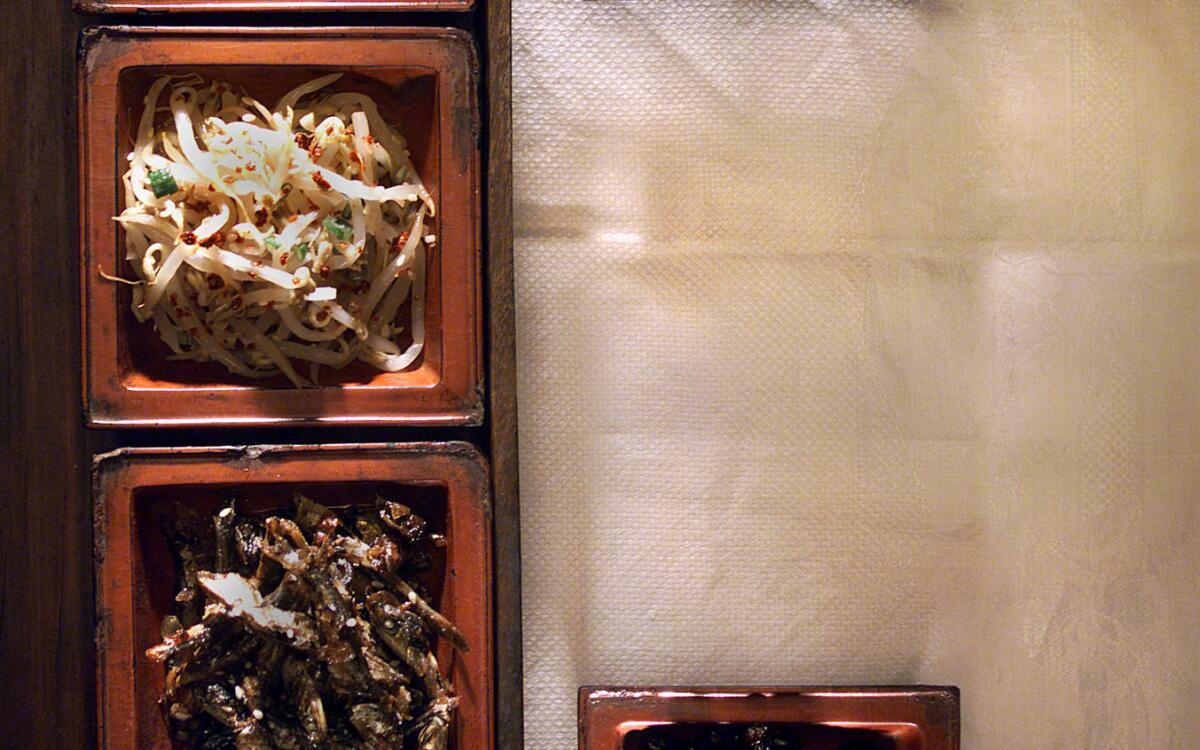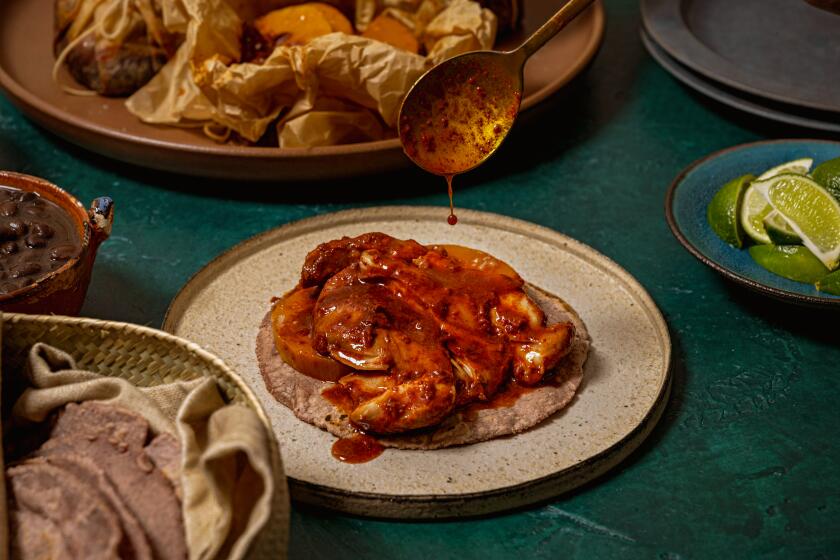Tofu Chorim (Tubu Chorim)

- Share via
When I take friends to a Korean restaurant, I always feel I spend more time explaining than actually eating. Whenever a dish is placed on the table, everyone points and asks, “What’s that?” as they wave their chopsticks cautiously about the food. Depending on which restaurant we’re in, that could be repeated anywhere from five to 20 times.
If I’m in a particularly nice mood, I will carefully explain the dish, list all the ingredients and describe how it’s prepared, how spicy it is and how it should be eaten. On days when I’m feeling lazy, annoyed or just plain mischievous, I give some noncommittal answer: “It’s just some stuff thrown together,” or “Just try it and see if you like it.”
Anything eaten with rice is given the all-purpose name panchan. Panchan can be anything from an elaborate fish dish to kimchi to some sauteed vegetables. All the little dishes that come with a meal are called mit panchan, which loosely translates to something like bottom or base panchan. They are the foundation and support for the main panchan-kind of like the relishes and pickles in a Midwestern meal. A Korean meal isn’t complete without a couple of main dishes (or panchan), at least half a dozen smaller dishes (mit panchan) and some sort of soup or water kimchi to help wash it down.
When I’m entertaining at home, not only do I have to make a couple of main dishes, I also have to make sure there are plenty of mit panchan too. Once when I was rushing around trying to put a meal together, I realized I’d forgotten to make a soup. My boyfriend didn’t know what the big deal was. “Can’t we just skip the soup?” he asked innocently.
No. We can’t just skip the soup. My mom raised me right; there has to be a liquid with a meal.
When you look out on a Korean table filled with little dishes, you may think it took a tremendous amount of time and effort, but it doesn’t have to. I’ve been able to put together a last-minute feast in a little more than an hour. It’s easier for me because I have most of the ingredients at hand, but take one trip to the Korean grocery and you too can whip up a great dinner in no time.
When putting a meal together, just make sure you have the following: rice, at least one type of kimchi, a liquid, at least a couple of main panchan (usually with meat, chicken or fish), and a handful of mit panchan.
Let’s take it in steps. First, the rice. This part is easy, especially if you have an electric rice cooker. Even if you don’t, you can prepare the rice first and do something else while it’s cooking.
Next, the kimchi. You should always have kimchi in the house anyway, but if you don’t, you can buy it ready-made, packaged in glass jars, plastic containers or even bags. Some of the less common kimchi may be harder to find, but the traditional nappa cabbage kind can be found in the refrigerated sections of even some non-Asian supermarkets.
Next, there’s the main panchan. A main panchan can be something easy, like bulkogi (grilled beef), or something complicated, like chapchae (Korean yam noodles). It’s up to you.
Now, the fun part-the mit panchan. In the deli section of larger Korean supermarkets. you may see a variety of these laid out for your convenience. The little dishes can be anything from pickled lotus roots to sauteed spinach. They can be salty, sour, sweet, spicy or any combination.
Some of the dishes need to be prepared weeks ahead (especially if you’re pickling anything).Once you get the hang of making certain dishes, you can mix and match the ingredients. Just as long as there is a balance of hot and cold, spicy and sweet, crispy and soft, the meal will be great.
Oh yeah, and don’t forget the soup.
Rinse the tofu block in cold water then cut it in half, then into approximately 1/2-inch slices. Set the tofu aside on paper towels or in a wire-mesh colander to drain.
Combine the soy sauce, garlic, green onions and optional red pepper or chile powder. Set aside.
Heat the oil in a large skillet over high heat. Working in two batches, carefully place the tofu into the skillet, making sure each rectangle rests flat on the bottom. (Be careful, because the water in the tofu will make the oil splatter.) You may wish to cover the skillet with a wire-mesh splashguard. Cook the tofu until it is lightly browned on both sides; don’t overcook or it will lose its moisture and texture.
Reduce the heat to low and spoon the soy mixture over each tofu slice. Cover and cook until the tofu is slightly steamed and infused with the seasoning, another 2 or 3 minutes.
Get our Cooking newsletter
Get a taste of Los Angeles — and the world — with recipes and kitchen tricks from the L.A. Times’ Cooking newsletter.
You may occasionally receive promotional content from the Los Angeles Times.















